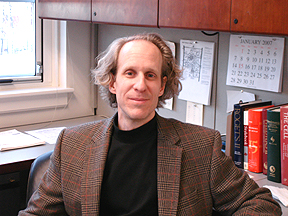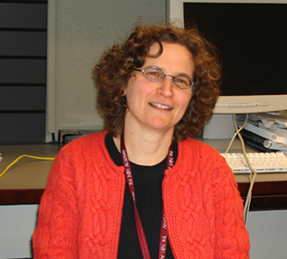THIS
GUY MIGHT COME
KNOCKING
 |
|
Christopher
Wanjek
|
As the new director of communications for the Office of Intramural Research, I need to hear from you and learn about your research. Seeing how there are only a few thousand intramural scientists working at NIH, this shouldn’t take too long.
Hopefully I can wrap this up by the spring, although I won’t venture as to which year this would be.
I see my role here as enabling you to share information with each other. Perhaps this will be through newsletter articles relaying your research or through electronic bulletin-board postings with Michael Gottesman about day-to-day issues and concerns that affect your work. I’m open to new ideas, and one of my first tasks is to assess the OIR’s communications needs.
This is a new challenge for me, although I’m not entirely unfamiliar with your work. Most of my career has been spent relaying scientific information to the public. I have an undergraduate degree in journalism and a master’s degree in health. For the past nine years I wrote primarily about astrophysics for NASA.
During this time, however, I freelanced considerably. My output included two health books, a weekly health column on LiveScience.com, and about 100 health and science articles for the Washington Post and other publications. The most recent book, Food at Work: Workplace Solutions for Malnutrition, Obesity and Chronic Diseases, was written for the U.N.’s International Labor Organization.
Please call or e-mail me with news about your research or ideas about improving communications in the OIR. Ultimately I would like to meet face to face. It has been a thrill so far, in my first month here, to visit a few labs and to see how the work is actually done. Meeting scientists in their work environment enables me to bring some of the research excitement to life.
I’m at 301-402-4274; or e-mail me.
Director of Communications, OIR
SHE HOPES TO SEE THOUSANDS OF YOU
 |
|
Sharon
Milgram
|
Sharon Milgram is in the process of moving her lab from the University of North Carolina School of Medicine, Chapel Hill, to the Bethesda campus of NIH. She’s also packing her two well-worn hats for the trip.
A professor of cell and developmental biology at UNC, Milgram has also been an administrator there for more than a decade, serving as a postdoc advisor, the director of various graduate programs, and the director of the Interdisciplinary Biomedical Sciences Program.
With a joint NHLBI-NHGRI appointment that will enable her to continue her cystic fibrosis research here, she is poised to become the first director of the recently reconstituted Office of Intramural Training and Education (OITE). Her first priority in that position is to replace "hit or miss" career counseling that varies with the resources of the individual institutes and centers with a formal science-focused career center on the Bethesda campus that will help trainees in transition at all levels. She’d like to see it up and running before year’s end.
The career center will reach out to trainees at all the NIH facilities, which means that staff will need to travel occasionally to outposts such as Frederick and North Carolina. "Breeze and iChat," Milgram observes, "are certainly improvements, but sometimes you need to be able to sit opposite someone and talk."
Nationally, she notes, career counseling and professional development have been identified as inadequately met needs in the field of biomedical research. According to the Sigma Xi postdoc survey (see The NIH Catalyst, November-December 2006), participation in career-development activities is a major component of success. "It’s not just getting papers published in high-visibility journals—that’s the wrong message to send to trainees."
Milgram has been commuting between Chapel Hill and Bethesda, but will take up permanent residence here in April. She expects to split her time between her laboratory and OITE much the way she has for the past decade at UNC. "I think being an active scientist—active in the lab training students, postdocs, and postbacs—is value-added to the job at OITE. It’s a huge benefit to have a scientist’s perspective."
Milgram will be bringing a cohort of grad students, postbacs, and postdocs with her—between five and seven people—to continue her lab’s cell-signaling and cystic fibrosis research. "Several years ago, we embarked on developing proteomic approaches to identify novel proteins associated with cystic fibrosis. We’ve identified three clear, interesting proteins and characterized the function of two of them; we want to do the same for the third and explore more exhaustively the first two—how they regulate the movement of CFTR through the cell as well as their ability to function on the surface of the cell."
The new director will also be offering The NIH Catalyst a continuing OITE column starting with the May–June issue. "I’ll have some time for this," she says, smiling, "since I won’t be spending time any more writing grants."
To learn more about the work of the Milgram lab, see the website.